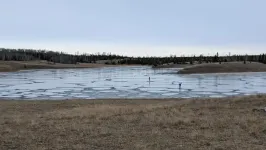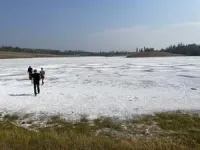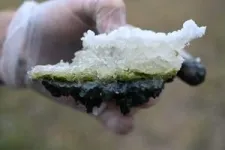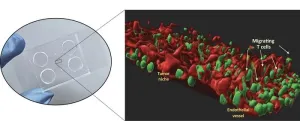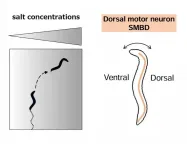(Press-News.org) Charles Darwin proposed that life could have emerged in a “warm little pond” with the right cocktail of chemicals and energy. A study from the University of Washington, published this month in Communications Earth & Environment, reports that a shallow “soda lake” in western Canada shows promise for matching those requirements. The findings provide new support that life could have emerged from lakes on the early Earth, roughly 4 billion years ago.
Scientists have known that under the right conditions, the complex molecules of life can emerge spontaneously. As recently fictionalized in the blockbuster hit “Lessons in Chemistry,” biological molecules can be coaxed to form from inorganic molecules. In fact, long after the real-life 1950s-era discovery made amino acids, the building blocks of proteins, more recent work has made the building blocks of RNA. But this next step requires extremely high phosphate concentrations.
Phosphate forms the “backbone” of RNA and DNA and is also a key component of cell membranes. The concentrations of phosphate required to form these biomolecules in the lab are hundreds to 1 million times higher than the levels normally found in rivers, lakes or in the ocean. This has been called the “phosphate problem” for the emergence of life — a problem that soda lakes may have solved.
“I think these soda lakes provide an answer to the phosphate problem,” said senior author David Catling, a UW professor of Earth and space sciences. “Our answer is hopeful: This environment should occur on the early Earth, and probably on other planets, because it's just a natural outcome of the way that planetary surfaces are made and how water chemistry works.”
Soda lakes get their name from having high levels of dissolved sodium and carbonate, similar to dissolved baking soda. This occurs from the reactions between water and volcanic rocks beneath. Soda lakes can also have high levels of dissolved phosphate.
Previous UW research in 2019 found that chemical conditions for life to emerge could theoretically occur in soda lakes. The researchers combined chemical models with laboratory experiments to show that natural processes can theoretically concentrate phosphate in these lakes to levels up to 1 million times higher than in typical waters.
For the new study, the team set out to study such an environment on Earth. By coincidence, the most promising candidate was within driving distance. Tucked away at the end of a master’s thesis from the 1990s was the highest known natural phosphate level in the scientific literature at Last Chance Lake in inland British Columbia, Canada, about seven hours’ drive from Seattle.
The lake is about 1 foot deep and has murky water with fluctuating levels. It sits on federal land at the end of a dusty dirt road on the Cariboo Plateau, in British Columbia ranching country. The shallow lake meets the requirements for a soda lake: a lake above volcanic rock (in this case, basalt) combined with a dry, windy atmosphere that evaporates incoming water to keep water levels low and concentrates dissolved compounds within the lake.
Analysis published in the new paper suggests soda lakes are a strong candidate for the emergence of life on Earth. They also could be a candidate for life on other planets.
“We studied a natural environment that should be common throughout the solar system. Volcanic rocks are prevalent on the surfaces of planets, so this same water chemistry could have occurred not just on early Earth, but also on early Mars and early Venus, if liquid water was present,” said lead author Sebastian Haas, a UW postdoctoral researcher in Earth and space sciences.
The UW team visited Last Chance Lake three times from 2021 to 2022. They collected observations in early winter, when the lake was covered in ice; in early summer, when rain-fed springs and snowmelt-fed streams put water at its highest; and in late summer when the lake had almost completely dried up.
“You have this seemingly dry salt flat, but there are nooks and crannies. And between the salt and the sediment there are little pockets of water that are really high in dissolved phosphate,” Haas said. “What we wanted to understand was why and when could this happen on the ancient Earth, in order to provide a cradle for the origin of life.”
On all three visits the team collected samples of water, lake sediment and salt crust to understand the lake’s chemistry.
In most lakes the dissolved phosphate quickly combines with calcium to form calcium phosphate, the insoluble material that makes up our tooth enamel. This removes phosphate from the water. But in Last Chance Lake, calcium combines with plentiful carbonate as well as magnesium to form dolomite, the same mineral that forms picturesque mountain ranges. This reaction was predicted by the previous modeling work and confirmed when dolomite was plentiful in Last Chance Lake’s sediments. When calcium turns into dolomite and does not remain in the water, the phosphate lacks a bonding partner — and so its concentration rises.
“This study adds to growing evidence that evaporative soda lakes are environments meeting the requirements for origin-of-life chemistry by accumulating key ingredients at high concentrations,” Catling said.
The study also compared Last Chance Lake with Goodenough Lake, a roughly 3-foot-deep lake with clearer water and different chemistry just a two-minute walk away, to learn what makes Last Chance Lake unique. The researchers wondered why life, present in all modern lakes at some level, was not using up the phosphate in Last Chance Lake.
Goodenough Lake has mats of cyanobacteria that extract or “fix” nitrogen gas from the air. Cyanobacteria, like all other lifeforms, also require phosphate — and its growing population consumes some of that lake water’s phosphate supply. But Last Chance Lake is so salty that it inhibits living things that do the energy-intensive work of fixing atmospheric nitrogen. Last Chance Lake harbors some algae but has insufficient available nitrogen to host more life, allowing phosphate to accumulate. This also makes it a better analog for a lifeless Earth.
“These new findings will help inform origin-of-life researchers who are either replicating these reactions in the lab or are looking for potentially habitable environments on other planets,” Catling said.
The research was funded by the Simons Foundation. The other co-author is Kimberly Poppy Sinclair, a UW graduate student in Earth and space sciences. Graduate students with the UW Astrobiology Program also assisted with sample collection.
###
For more information, contact Haas at sb704989@uw.edu or Catling at dcatling@uw.edu.
END
The exponential demand for high computing power is far exceeding the capabilities of current electronic systems; however, engineers at the University of Pittsburgh are shining a light on new solutions.
Nathan Youngblood, principal investigator and assistant professor of electrical and computer engineering at Pitt’s Swanson School of Engineering, received a $552,166 Faculty Early Career Development Award from the National Science Foundation (NSF) and a $449,240 award from the Air Force Office of Scientific Research (AFOSR) through its Young Investigator Program (YIP) to continue his pioneering work in phase-change materials and optical computing.
“Dr. ...
Milano, January 22nd 2024 – It is only a few centimeters in size and can be held between two fingers, but in the micro-channels carved inside it, it’s hidden a three-dimensional and highly faithful model of a biliary tract cancer called cholangiocarcinoma, complete with its tumor microenvironment. This 3D model is built starting from a sample of patient’s cancer cells and thus it represents a patient-specific "organ-on-chip": a technology made possible only through a multidisciplinary approach that merges biomedicine, physics and engineering.
The innovative prototype is the result ...
More than 11 million people in the United States take anticoagulation or antiplatelet medications, such as heparin or aspirin, to treat serious conditions like heart attack and stroke. However, these medications also put patients at risk of life-threatening bleeding in the case of injury or during surgery. To improve strategies for reducing blood loss, a team led by investigators from Brigham and Women’s Hospital, a founding member of the Mass General Brigham healthcare system, developed a porous material that maximizes blood absorption and effectively activates clotting mechanisms, even in patients on anticoagulation or ...
New biomarkers with improved diagnostic performance for early detection of lupus nephritis have been discovered in the University of Houston lab of Chandra Mohan, a pioneer in lupus research. Early identification of renal involvement in lupus and prompt treatment are essential in reducing the pain, suffering and eventual mortality it causes.
Systemic Lupus Erythematosus (SLE), commonly called lupus, is an autoimmune disease that occurs when the body attacks its own tissues and organs. Inflammation from the disease can impact many different parts of the body including joints, skin, kidneys, blood cells, brain and heart. Lupus nephritis is one ...
Motion capture technology has applications in a wide range of fields, including entertainment, medicine, and sports, to name a few. But what if the measurements these systems were based on were rooted in social practices and biased assumptions, leading to errors that become ingrained over time?
This question is at the heart of new research co-authored by Mona Sloane, an assistant professor of data science and media studies at the University of Virginia.
Sloane and her co-authors — Abigal Jacobs, an assistant ...
Genetic changes or mutations can cause hereditary kidney disease, which can eventually lead to dialysis or the need for kidney transplantation. Identifying the cause of inherited kidney disease is the first step in identifying a treatment.
With that goal in mind, researchers at Wake Forest University School of Medicine and the First Faculty of Medicine of Charles University in Prague, Czech Republic, have discovered a new genetic cause of inherited kidney disease.
The findings were recently published in Kidney International.
According to Anthony J. Bleyer, M.D., ...
MIT neuroscientists have found that the brain’s sensitivity to rewarding experiences — a critical factor in motivation and attention — can be shaped by socioeconomic conditions.
In a study of 12 to 14-year-olds whose socioeconomic status (SES) varied widely, the researchers found that children from lower SES backgrounds showed less sensitivity to reward than those from more affluent backgrounds.
Using functional magnetic resonance imaging (fMRI), the research team measured brain activity as the children played a guessing game in which they earned extra money for each correct ...
During the past decade, there has been significant development of new sulfur containing compounds that are used in various industries, including pharmaceuticals and agricultural products. Sulfoximines, sulfonimidoyl fluorides and sulfonimidamides are types of sulfur-containing chemical compounds that have wide-ranging potential as therapeutic drugs. However, the synthesis process for these compounds is complex and has several limitations. In a new article published in Nature Chemistry, Moffitt Cancer Center researchers describe their ...
We are tasking our computers with processing ever-increasing amounts of data to speed up drug discovery, improve weather and climate predictions, train artificial intelligence, and much more. To keep up with this demand, we need faster, more energy-efficient computer memory than ever before.
Researchers at Stanford have demonstrated that a new material may make phase-change memory—which relies on switching between high and low resistance states to create the ones and zeroes of computer data—an improved option for future AI and data-centric systems. ...
Joint research led by Ayaka Matsumoto and Yuichi Iino of the University of Tokyo demonstrated that temporal decrease in salt concentration leads to the activation of the neck motor neuron of roundworms only in a specific phase of its activity. The activation adjusts the roundworm's trajectory toward higher salt concentrations. The finding pinpoints the neural mechanism by which roundworms integrate sensory and motor information, a first step toward understanding the neural mechanisms of navigation in more complex animals. The findings were published in the journal Proceedings ...
